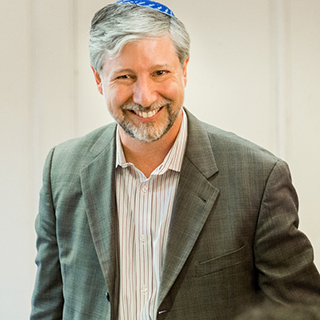Finding Meaning in the Festival of Lights

A Hasidic Lesson for Hanukkah from the Sefat Emet.
A Livestream Lunch and Learn with Rabbi Daniel Nevins, Pearl Resnick Dean of The Rabbinical School and dean of the Division of Religious Leadership, JTS
א”ז מו”ר זצלה”ה אמר מה שמברכין שעשה נסים על ראיית נר חנוכה. כי הארת הנסים הם בהנרות. ובאמת כ’ הנרות הללו קודש הם. ונראה כי מאחר שהיה הדלקת המנורה בימים אלו עפ”י נס אף שלא הי’ שמן לבנ”י להדליק. א”כ גם עתה אף שאין לנו מנורה ושמן טהור. ג”כ שייך ההדלקה עפ”י הנס. מאחר שנס זה נשאר לדורות. רק הכלי להדלקה הזו הוא מצות הדלקת נר חנוכה דכתיב נר מצוה ותורה אור. הפי’ נר הוא כלי לקבל שמן ופתילה ואור
My grandfather, my teacher, may his righteous memory be for a blessing, said, “Why do we make the blessing, ‘…who made miracles for us in those days at this time’ when we see the Hanukkah candles? It is because the miracles of Hanukkah are apparent within the candles.” And it is truly written that, “these candles are holy.” Apparently, the lighting of the Menorah in those days [of the Maccabees] was miraculous for there was insufficient oil for the Israelites to light it. So too in our time we lack the lamp and the pure oil, and it is therefore the case even now that we light the Menorah via a miracle. For this miracle remains active for all generations. The container for this (continuous) miracle is the commandment to light the Hanukkah candles, as it is written, “for the commandment is the lamp, and Torah is the light” (Proverbs 6:23). That is to say that the lamp is a vessel that receives the oil and the wick and the light.
כן המצות נגד רמ”ח איברים ויראה ואהבה גי’ נר כ”כ בתיקונים. והוא שהמצות הם במעשה. ואור התורה נתלה בהם. שהרי המצות כתובים בתורה ועי”ז יתוקן המעשה ג”כ. והוא תיקון גוף איברי האדם. והתורה להביא דעת וחכמה לאדם. וגם לשון נר חנוכה שתיקנו חז”ל בברכת המצוה ג”כ כנ”ל דלא כ’ להדליק נר בחנוכה. רק שיש נר חנוכה. ועל ידי קיום המצוה מדליקין זה הנר הידוע. ובאמת הלא המשכן נגנז וכן המנורה וא”כ בימים האלו שהי’ ההדלקה אז עפ”י נס גם עתה היא דולקת
Thus, the commandments align with the gematria (numerology) of the 248 limbs of the body plus the words fear and love, to equal the gematria of the word candle. The commandments themselves are embodied in action, and “the light of Torah” is suspended within them. The commandments are written in the Torah, and it is through these commandments that our actions are repaired. This is the repair of the body and limbs of humanity. The Torah brings wisdom and insight to humanity. And the blessing […to light] “the lamp of Hanukkah” that the rabbis established [is precise]; it is not written, to light a lamp on Hanukkah; for there already is a Hanukkah lamp. By fulfilling the mitzvah, we are lighting that very lamp [i.e. the original one]! In truth, was not the Tabernacle hidden away and the Menorah as well [in ancient times]? Thus just as the Menorah was lit in those days via a miracle, so too now it is only through a miracle that the Menorah is lit.
וכעין זה אמר אא”ז מו”ר זצלה”ה על נר מערבי כיון שדולק בנס. דולק גם עתה במקום שנגנז כנ”ל. ורק לעורר ולהדליק זה ע”י מצות נר חנוכה שתקנו חז”ל. שע”י המצוה נזכר הארת הנס. [וכן הלשון בטור להזכיר הנס ולא לזכור ע”ש סי’ תרע”ט] וכל אלו הענינים משכן ומנורה הם נמצאים ברמז בכל איש מישראל שזה מה שיש לכל אחד מישראל חלק בתורה [והארת המנורה שגנוזים כמו כן באדם ובימים הללו יכולין לעורר ההארות הנ”ל שהם בחי’ המדות]
And on this my grandfather, my teacher, may his righteous memory be for a blessing, taught, “Just as the western lamp was lit through a miracle, it is still lit now in the place that it is hidden.” And this is awakened and lit through the lighting of the Hanukkah candles that the rabbis established. It is through the commandment of lighting the candles that the miracle is recalled. All of these items, [such as] the Tabernacle and the Menorah–they are hinted at in every Jew, that every Jew has a part of the Torah. [During these days, the hidden Menorah that is within a person can be awakened as mentioned above, as it is an essential part of one’s attributes.]
Guiding Questions
1. When you “perform” a mitzvah, what do you suppose is its effect? Is it just a symbolic action, or is there some sort of consequence?
2. How do you understand the claim that our performance of candle lighting is actually directly linked to the Temple ornaments?
3. What does it mean to “repair” one’s actions and body? What is “out of order” in them, and how does the practice of mitzvot repair them?



